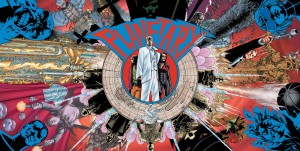Interesting article at Robot 6 about webcomics that come to an end. The basic economy of webcomics – they’re freely available, and almost always free to read – means that the barrier to entry for a creator is low, but the return on investment can also be low. So many webcomics end after a few strips, and many more end – deliberately or through neglect – some time later:
“Over 15,000 webcomics now exist online,†Wikipedia tells us, but probably 14,000 of those stopped updating after six episodes. This is the dark side of The Promise of Webcomics: It is true that anyone can start a webcomic, and that without the usual barriers to publication, such as editors and budgets, the web has become a seething cauldron of creativity. However, things like slush piles and contracts and editors are there for a reason: Not just to keep the crap out, but also to make sure the creator finishes the damn comic. The internet imposes no such restrictions. Consequently, many webcomics start with a burst of enthusiasm and fizzle when the creator runs out of ideas or has to study for finals.
The parallels to blogging are obvious. I’ve been blogging for over 12 years now, and my direct return on that investment is measured in Amazon.com referrals. The indirect returns, on the other hand – in the form of friends and acquaintances and the things that friends and acquaintances can bring you – have been much greater. Not to mention that I enjoy blogging, which is the direct impetus keeping me going. (I could arguably make some money by putting ads on my blog. I doubt it would be enough money to make a difference in my life – I’m just not a popular enough blogger – and it might not even be enough to justify the effort to put up the ads in the first place.)
I’m enthusiastic enough about the webcomics I read that I have a fairly meticulous system for keeping up with them through RSS feeds and bookmarks. I also enjoy finding a great new webcomic with an extensive archive, and I will buy the print collections of the webcomics I most enjoy. But apparently I’m unusual in that respect, and for many readers a large backstory is a barrier to entry.
But then, this is a problem that mainstream superhero comic books have been dealing with for years: How to satisfy their meat-and-potatoes fans who are into the continuity, while still bringing in new readers. Television series have the same problem. The economics of those media are different, but the problem is similar.
Myself, I’d suggest to someone who finds a new webcomic they enjoy with a large archive not to be put off by it. Enjoy the recent strips for what they are, but also consider going back to read through the archive, even if over a period of weeks or months. You might find it well worth the time invested. And I’d suggest to the creators of those strips that they keep their “About This Comic”/”New Readers” pages up-to-date so new readers can jump in and feel oriented right away; it’s unfortunately quite common to come across strips whose orientation pages seem years old. (As a reader, I’d also rather see an orientation page than a list of cast members; I’d rather learn about the cast by reading the strip.)
For new webcomic creators who find their enthusiasm waning after a few strips, consider that someone who seems like an “overnight success” usually has put in years of work to get to that point, it just seems to other people like that success came overnight. But I bet that much like blogging, you need to be doing a webcomic because it’s what you want to do. Because I don’t think very many people make a living drawing webcomics.
(Another interesting read is State of the Webcomics Union by Jeph Jacques of Questionable Content.)

























